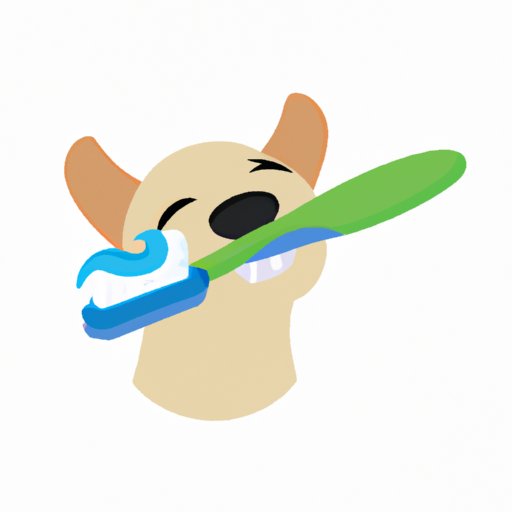
Introduction
As a dog owner, you might not put much thought into brushing your pet’s teeth. After all, they’re animals, right? Wrong. Dental care is just as important for dogs as it is for humans. Regular brushing can help prevent bad breath, tartar buildup, and gum disease, keeping your furry friend healthy and happy. In this article, we’ll show you how to brush your dog’s teeth, step-by-step.
Step-by-Step Guide
Brushing a dog’s teeth might seem daunting at first, but with a bit of patience and practice, it can become a routine part of your pet care regimen.
Step 1: Gather Your Supplies
Before you get started, make sure you have all the supplies you need. You’ll need a dog toothbrush, toothpaste, and treats to reward your dog. Dog toothbrushes are specially designed with soft bristles and long handles that make it easier to reach all the teeth. Dog toothpaste comes in a variety of flavors, such as chicken and beef, making it more palatable for your furry friend. Never use human toothpaste, as it can be harmful to dogs.
Step 2: Get Your Dog Used to the Toothbrush
Introduce the toothbrush to your dog before you start brushing. Let them sniff it, taste the toothpaste, and get comfortable with the process. You may want to start by letting your dog chew on the toothbrush or offering them a small dab of toothpaste on your finger. Once your dog is comfortable, start brushing.
Step 3: Use the Right Toothpaste
Apply a small amount of toothpaste to the brush and gently lift your dog’s lip, exposing their teeth. Start with the front teeth and work your way back. Brush in a circular motion, paying attention to the gum line. Be sure to avoid the tongue and inside of the mouth, as this can cause your dog to gag.
Step 4: Start Brushing
Brushing should take no more than 2-3 minutes. If your dog is not used to brushing, start with short sessions and gradually increase the time as they become more comfortable. Don’t forget to reward your dog with treats and praise throughout the process.
Step 5: Reward Your Dog
After brushing, give your dog a treat and plenty of praise. This helps to reinforce positive behavior and will make the experience more enjoyable for your furry friend.
Benefits of Brushing
The benefits of brushing your dog’s teeth go beyond just fresh breath. Good dental hygiene can also prevent more serious health concerns, such as gum disease and tooth decay. According to the American Veterinary Dental Society, 80% of dogs show signs of dental disease by age 3. Regular brushing can prevent this from happening. It can also help prevent bad breath, which can be a sign of underlying health issues.
Best Practices
When it comes to brushing your dog’s teeth, there are some best practices to keep in mind:
Using a Specially Designed Toothbrush
Using a toothbrush designed for dogs is important as it is specifically designed with the right size and bristles for your dog’s teeth and gum. Never use a human toothbrush.
Avoiding Abrasive Toothpaste
Abrasive toothpaste can cause damage to your dog’s teeth and enamel. Be sure to use a toothpaste that is specially designed for dogs and formulated to be gentle while cleaning teeth and freshening breath.
Brushing in a Gradient Motion
Brush your dog’s teeth in a gradient, back-and-forth motion concentrating on the gumline. This motion is important as it promotes blood flow throughout the gumline.
Brushing All Teeth, Including the Back Ones
Make sure you brush all teeth, even the back ones which are often neglected. These teeth are the most prone to infection and disease.
Troubleshooting Tips
Even with proper brushing techniques, there are common issues that dog owners may encounter:
Cleaning the Back Teeth
Cleaning the back teeth can be difficult for both dog and owner. Consider using a finger brush and smaller toothbrush for easier access. Be sure, however,that the toothbrush and finger brush are soft and gentle so you don’t hurt your dog’s gums.
Removing Tartar
If you notice a build-up of tartar on your dog’s teeth, schedule a visit with your veterinarian, who can clean it professionally with dental scaling equipment.
Dealing with Resistive Dogs
If you are having trouble with your dog resisting brushing their teeth, consider changing the toothpaste flavor or try using a dental spray which doesn’t require a toothbrush. It sprays into their mouth and covers all the teeth quickly and easily and doesn’t need any brushing
Product Reviews
There are a variety of dental products available for dogs, but which one is right for you and your furry friend? We’ve reviewed some of the top products on the market:
Toothpastes
Virbac CET Enzymatic Toothpaste is a popular choice among pet owners, as it contains enzymes that work to control plaque and freshen breath.
Toothbrushes
The Arm & Hammer Super Treadz Dental Dog Toys Toothbrush is a fun and easy way to keep your dog’s teeth clean. The rubber material is gentle on teeth and massages the gums.
Dental Chews
The Greenies Original Dental Chews are a tasty way to help clean your dog’s teeth. These chews are formulated to reduce tartar buildup and freshen breath.
Water Additives
The Nylabone Advanced Oral Care Liquid Tartar Remover is a simple and effective way to promote good dental hygiene. Simply add a capful to your dog’s water bowl, and it works to combat tartar and freshen breath.
Conclusion
Brushing your dog’s teeth is an important part of pet care that should not be overlooked. With the right supplies, techniques, and a bit of effort, you can keep your furry friend’s teeth healthy for years to come. Remember that dental care is not only important for fresh breath, but for preventing more serious health concerns down the road. With patience, practice, and a little bit of love, you can make brushing a positive experience for both you and your dog.





